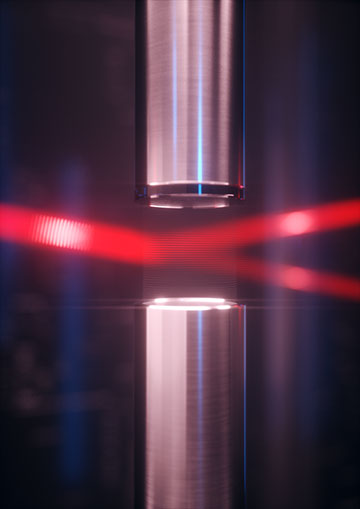
A laser light beam passes between a loudspeaker-reflector array that creates a grating of air. The laser beam interacts with this grating and is deflected without contact. [Image: Science Communication Lab for DESY]
In basic science classes, students learn that the changes in refractive index at the interfaces between materials provide the foundation for many ways to control light. Air’s refractive index is so close to 1 that it doesn’t get much attention by itself.
Yet, at the tiniest of incident angles, even a refractive index change on the order of 10−5 at a gaseous boundary layer can have large effects. For example, air layers at varying temperatures can produce mirages.
Now, researchers based in Germany have harnessed this effect by creating an optical Bragg grating with high-pressure ultrasound waves (Nat. Photon., doi:10.1038/s41566-023-01304-y). The experiments, conducted in ambient air, demonstrated a deflection efficiency of greater than 50 percent while avoiding the pitfalls of solid media, such as narrow spectral ranges, light-induced damage and nonlinear effects.
Cranking up the volume
Scientists already use the interaction between optical and acoustic waves for Q-switching in solid-state lasers and other applications requiring signal modulation, but practical acousto-optic devices involve solid and liquid media. Calculations of Bragg diffraction by the researchers at Deutsches Elektronen-Synchrotron (DESY) and Helmholtz Institute Jena, both in Germany, revealed several requirements for efficient modulation in air: a sufficiently shallow incidence angle of the light beam and optimization of the length of the sound transducer.
The DESY–Helmholtz team directed a beam of ultrashort near-infrared laser pulses to make seven passes through an ultrasound field volume 7 cm across. The multiple passes lengthened the beam’s path through the acoustic field. The first experiment used a mode-locked femtosecond laser with an average output power in the tens of milliwatts, but the second experiment involved a burst-mode laser with an average power of 3.5 kW and peak powers up to 20 GW, while still preserving excellent beam quality.
According to Yannick Schrödel, a doctoral student at DESY and Helmholtz, the deflection effect first became noticeable when the sound was at 130 dB, but the team cranked up the sound to 148 dB for the main experiments. That decibel level is above the threshold of pain for humans and close to the noise levels that NASA uses to test spacecraft before launch—but the researchers did not need to put their equipment inside an acoustic chamber. “Surprisingly, because the ultrasound is so confined in the 7-cm diameter and 2-cm height resonator and is absorbed after a relatively short distance, the experiments were performed in the ambient laboratory air!” Schrödel says.
Schrödel, the study’s first author, credited team members from Technische Universität Darmstadt, Germany, for building the ultrasound transducer, which operated at 490 kHz—far above the upper limit of human hearing. “A transducer of this size, that transmits ultrasound waves at high frequency into air at our truly ludicrous acoustic power, is unmatched,” he adds.
A new direction
The researchers emphasized in a press release that the acoustic control of laser light in gases can probably also be transferred to optical elements such as lenses and waveguides.
According to Schrödel, the DESY-Helmholtz team’s air-based acousto-optic modulator is only the most primitive optical element in future “gas-phase sonophotonics” because it requires only a planar acoustic wave. The researchers emphasized in a press release that the acoustic control of laser light in gases can probably also be transferred to optical elements such as lenses and waveguides. How differently shaped sound waves could affect light beams is one of the group’s next avenues of study.
“The potential of contactless control of light and its extension to other applications can currently only be imagined,” explains project leader Christoph Heyl of DESY and Helmholtz. “Modern optics is based almost exclusively on the interaction of light with solid matter. Our approach opens up a completely new direction.”

